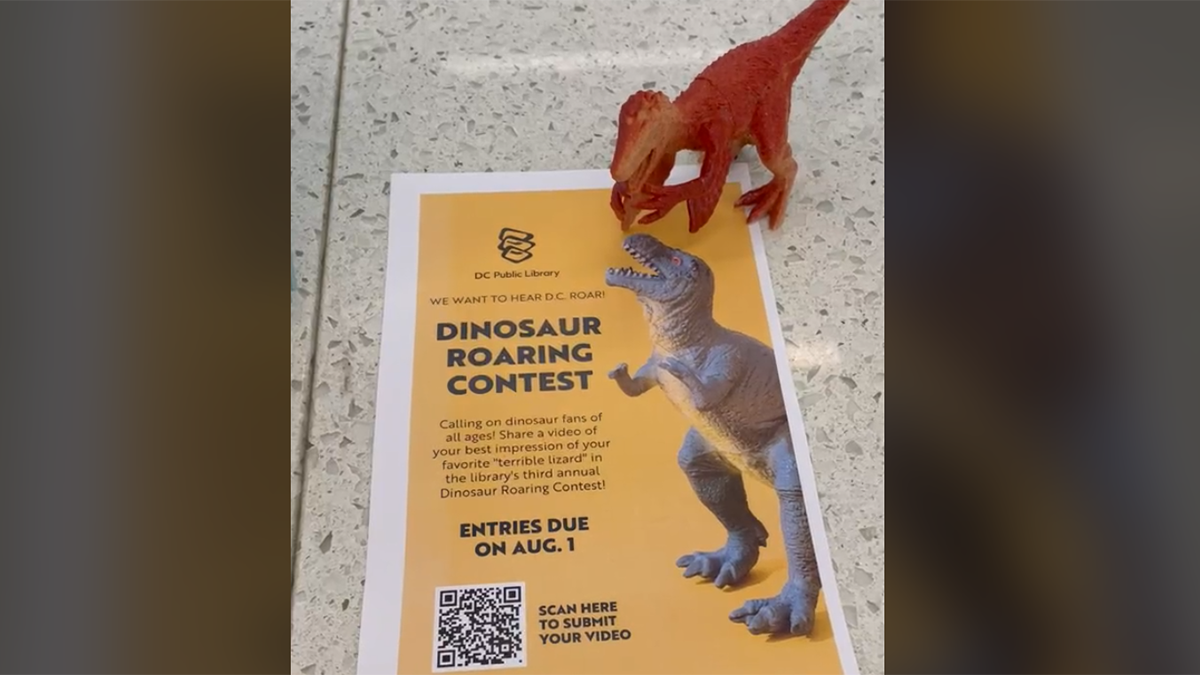
Paleontologist Peter Kranz doesn't necessarily expect to be a famous scientist ... although he admits that it's a nice notion.
"As a scientist, one wants to think that their scientific impact is on the research you've done," Kranz says.
But there's achievement that he knows "will long outlast the scientific work that I've done," he says. His slight smile hovers just above a T-shirt bearing that achievement's name: "Capitalsaurus."

We're making it easier for you to find stories that matter with our new newsletter — The 4Front. Sign up here and get news that is important for you to your inbox.
What exists of the official dinosaur of Washington, D.C., is nothing more than a single vertebrae. The fossil was unearthed almost a century before Kranz rediscovered it in the 1980s, in the depths of the Smithsonian's fossil collection. But Kranz's relentless passion for dinosaur research means Capitalsaurus still looms large in the District.
"It captured the imagination of the public," Kranz said. "And people write about it and discuss it and it produces lots of interest, because people like having an official dinosaur."
Read on for the story of Capitalsaurus, and how it came to have its own street corner, day of recognition, and legacy in D.C.
Industrial-era fossil discovery
While paleontologists have uncovered full or partial skeletons for a number of dinosaurs, Capitalsaurus isn't one of them. The only evidence of Capitalsaurus is one bone, first found by a construction crew on Jan. 28, 1898.
That crew was digging tunnels to upgrade the sewer system along F Street SE, between 1st and 2nd streets, when they found an unusual rock, according to the Library of Congress. Other bone fragments were also found, but the fossil that would eventually become Capitalsaurus was the most complete.
It was handed over to the Smithsonian Institution, where it was identified as a vertebrae from a large -- and unknown -- creature.

Over the decades, the D.C. fossil was identified variously as different kinds of large, meat-eating dinosaurs by arguing paleontologists. After its first discovery, it was packed away until 1911, put aside again until 1924, and then forgotten for more than 60 years.
The process for deciding whether a dinosaur fossil is a new species, or one we already know, can get dicey -- so it takes a long time.
"You have to say, 'This difference is enough that it doesn't just represent the difference between somebody who's six feet tall and somebody who's five feet tall,'" Kranz said.
For animals still living today, Kranz explained, you can look at two different living animals and clearly see where they diverge. Then you can compare bones and skeletons to those living creatures.
But for dinosaurs, there's no living creature to which to compare the bones. That makes classifying a single fossil as one dinosaur species or another more difficult.
What's in a dinosaur name?
On top of the basic challenges of physical classification, there are rules around the official identity of any potential new dinosaurs.
"Under the rules of international zoological nomenclature, you have to publish it in a journal, a peer reviewed journal, to formally name it," Kranz said. And that name can't have been used for any other known animal -- not just dinosaurs, but bugs and mammals and so on. (There's even an organization dedicated to the complicated process and its rules: the International Commission on Zoological Nomenclature.)
When Kranz came along in the late '80s, he said, there still wasn't a clear scientific consensus around what species that fossilized vertebrae belonged to. The best guesses were species that lived far away both in time and geography.
The last paleontologist to identify the bone, according to the Library of Congress, labelled the vertebrae with a question mark, as "Dryptosaurus ? potens," because it was so uncertain.
Dryptosaurus is another kind of large, meat-eating dinosaur -- but Kranz, after careful study of other, better-identified Dryptosaurus fossils, found that the D.C. vertebrae was different when it came to "size and shape and relative proportions."
"I argued that basically, we had a dinosaur that was a dinosaur, and it was a large meat-eating dinosaur, probably the largest meat-eating dinosaur known from the East Coast, but it wasn't any of the names that it previously had," Kranz said.
Kranz believed the fossil was different enough to give the dino a new species name -- but knew that could take decades to finalize. And with one attempt at a formal name publication that had already been used by "a beetle or something like that," the dinosaur fossil had lived in anonymity for a while.
The fossil was, "at that point, sort of an orphan as far as name goes. It didn't have a name," Kranz said.
So, to keep discussing it easily, Kranz gave it a nickname in a 1990 article for Washingtonian Magazine.
"This dinosaur, the only definitive and type specimen that was known was found on Capitol Hill in Washington, D.C., the capital of the United States," Kranz said. "So the "capitalsaurus" name means "dinosaur of the capital.""
The rise of Capitalsaurus
Kranz also runs a nonprofit called the Dinosaur Fund. Essentially, he is a dinosaur spokesperson.
"I try to get people and [the] government to put money toward protecting and researching the dinosaurs of this region as a resource," he said, to try and promote paleontology as a field. The details of scientific research can be intimidating, but everybody loves dinosaurs.
That deep connection and excitement is why Kranz donned a classic pith helmet for his interview with News4. Sure, it provides protection from one of the biggest real dangers in the field -- the sun -- but it also works like a doctor putting on a lab coat.

"It's symbolic in that, even though it's functional, if I'm not wearing it, the kids will say 'You're OLD!,' you know?" he said. "You'll be an old man or even a scary old man. But as soon as I put it on, then they know that I'm a paleontologist, and it completely changes the affect."
Kranz's public outreach is not new. In the late 1990s, he taught science at a couple of D.C. elementary schools. That time period lined up perfectly with the 100th anniversary of Capitalsaurus's discovery.
"In 1998 ... the students went before the city council," Kranz said. "And a formal bill was proposed to make [Capitalsaurus] the official dinosaur of the District of Columbia."
Thanks to the students at Smothers Elementary and thematically-appropriate Flintstone Elementary, the bill was successful. Then-D.C. Mayor Marion Barry declared Jan. 30, 1998 (and Jan. 28 of every year after that) to be Capitalsaurus Day.
Two years later, in 2000, the D.C. Council designated the intersection of 1st and F streets where the fossil was discovered as "Capitalsaurus Court." The special designation sign still stands to this day.

"The purpose of doing these kinds of things, like making an official dinosaur, has been vindicated multiple times," Kranz said. "Although some of the scientists are uncomfortable with it, others recognize the value. Because ultimately, science depends in large part on money coming from government and ultimately from the people."
More than 30 years after Kranz first asserted in scientific papers that the Capitalsaurus vertebrae was a new species, the official literature is actually still debating whether he's right. But he knows that D.C.'s official dinosaur, with its street corner, holiday and even short-lived beer, has left its mark on public sentiment -- and on his own legacy.
"It may be the thing that, if I'm remembered for anything, I'll be remembered for the Capitalsaurus," Kranz said.




